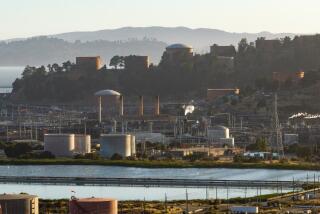L.A. Trade Grew at a Snail’s Pace Last Year
- Share via
International trade activity in the Los Angeles region grew last year at its slowest rate in more than a decade, reflecting weakened exports due to the strong U.S. dollar and disappointing performance of several Asian economies, according to a report released Tuesday.
The report, by the Los Angeles Economic Development Corp. (LAEDC), also predicted that 1997 is shaping up to be a “tumultuous” year. While the region’s trade volume is expected to grow about as much as it did last year, the report noted that Los Angeles leaders must be more engaged in the nation’s trade debates and take other steps “to fend off vigorous challenges to its international trade base.”
Last year the Los Angeles Customs District saw its dollar volume of traffic grow to $170.1 billion, up 3.6% from the previous year, mainly because of increased imports, the report said. While Los Angeles remained the nation’s busiest port, about $14 billion ahead of New York, the growth rate last year paled next to the double-digit increases in the previous two years and during the late ‘80s.
Exports passing through the Los Angeles district--which includes the ports of Los Angeles and Long Beach, Los Angeles International Airport, Port Hueneme and the Las Vegas airport--edged up by just 2.8% last year. Imports advanced by 4.1%, led by electrical machinery, sound equipment, motor vehicles and toys. Top exports were electrical machinery, sound equipment, aircraft parts and medical instruments.
The strengthening dollar, which makes it tough for U.S. businesses to compete overseas, hurt exports last year, as did slower-than-expected growth in Hong Kong, South Korea, Singapore and Taiwan, which are principal trading partners.
International trade, an increasingly critical element of California’s economy, directly accounts for 377,600 jobs in the five-county Los Angeles area, up from 95,000 in 1990, according to estimates by the LAEDC. But Jack Kyser, LAEDC’s chief economist, said the area’s international trade community must do a better job of communicating the job implications of trade to residents and government leaders, especially in the face of “a lot of bumps on the trade road in 1997.”
One concern is the uncertainty surrounding China, the Los Angeles district’s second-largest trading partner after Japan. At the national level, China’s most-favored nation status comes up for renewal. Locally, disputes have plagued the effort to build a new terminal in Long Beach for the China Ocean Shipping Co., or Cosco.
Kyser also worried about anti-free trade sentiments bubbling in the United States, which could affect the U.S. government’s review this year of the North American Free Trade Agreement. Also, questions abound about how trade might be affected after control of Hong Kong is passed to China in July.
“The new Los Angeles economy is more globally centered rather than U.S.-centered,” said Kyser. “So the region’s leaders will have to be more involved in discussions about international political and trade issues.”
More to Read
Inside the business of entertainment
The Wide Shot brings you news, analysis and insights on everything from streaming wars to production — and what it all means for the future.
You may occasionally receive promotional content from the Los Angeles Times.











